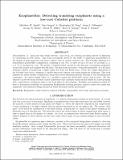ExoplanetSat: Detecting transiting exoplanets using a low-cost CubeSat platform
Author(s)
Smith, Matthew William; Seager, Sara; Pong, Christopher Masaru; Villasenor, Jesus Noel Samonte; Knapp, Mary E.; Farmer, Grant Trapnell; Jensen-Clem, Rebecca M.; Ricker, George R; Miller, David W; ... Show more Show less
DownloadSmith-2010-ExoplanetSat Detecting transiting exoplanets using a low-cost CubeSat platform.pdf (831.8Kb)
PUBLISHER_POLICY
Publisher Policy
Article is made available in accordance with the publisher's policy and may be subject to US copyright law. Please refer to the publisher's site for terms of use.
Terms of use
Metadata
Show full item recordAbstract
Nanosatellites, i.e. spacecraft that weigh between 1 and 10 kg, are drawing increasing interest as platforms for conducting on-orbit science. This trend is primarily driven by the ability to piggyback nanosatellites on the launch of large spacecraft and hence achieve orbit at greatly reduced cost. The CubeSat platform is a standardized nanosatellite configuration, consisting of one, two, or three 10 cm x 10 cm x 10 cm units (1, 2, or 3 "U"s) arranged in a row. We present a CubeSat-based concept for the discovery of transiting exoplanets around the nearest and brightest Sun-like stars. The spacecraft prototype - termed ExoplanetSat - is a 3U space telescope capable of monitoring a single target star from low Earth orbit. Given the volume limitations of the CubeSat form factor, designing a capable spacecraft requires overcoming significant challenges. This work presents the initial satellite configuration along with several subsystem-specific solutions to the aforementioned constraints. An optical design based on a modified commercial off-the-shelf camera lens is given. We also describe a novel two-stage attitude control architecture that combines 3-axis reaction wheels for coarse pointing with a piezoelectric translation stage at the focal plane for fine pointing. Modeling and simulation results are used to demonstrate feasibility by quantifying ExoplanetSat pointing precision, signal-to-noise ratio, guide star magnitude, and additional design parameters which determine system performance.
Date issued
2010-07Department
Massachusetts Institute of Technology. Department of Aeronautics and Astronautics; Massachusetts Institute of Technology. Department of Earth, Atmospheric, and Planetary Sciences; Massachusetts Institute of Technology. Department of Physics; MIT Kavli Institute for Astrophysics and Space ResearchJournal
Proceedings of SPIE--the International Society for Optical Engineering; v. 7731
Publisher
SPIE
Citation
Smith, Matthew W. et al. “ExoplanetSat: detecting transiting exoplanets using a low-cost CubeSat platform.” Space Telescopes and Instrumentation 2010: Optical, Infrared, and Millimeter Wave. Ed. Jacobus M. Oschmann et al. San Diego, California, USA: SPIE, 2010. 773127-14. © 2010 SPIE
Version: Final published version
ISSN
0277-786X